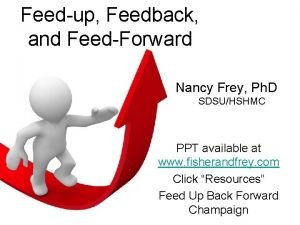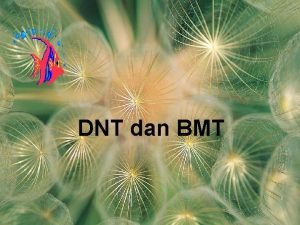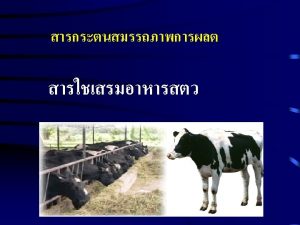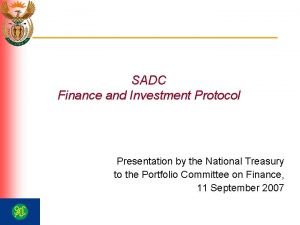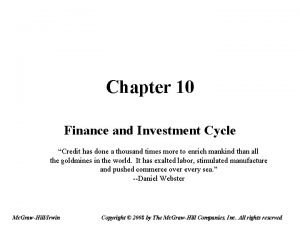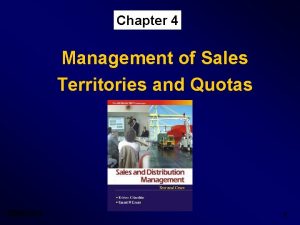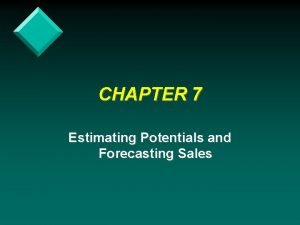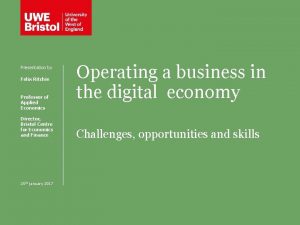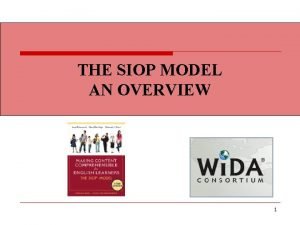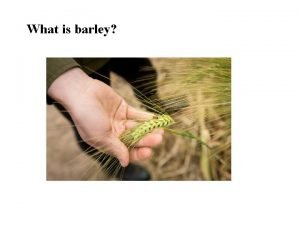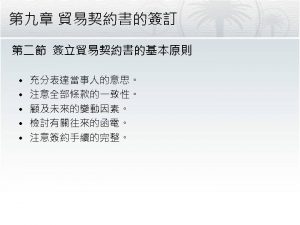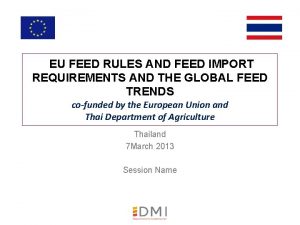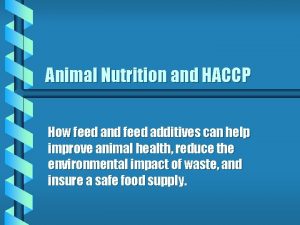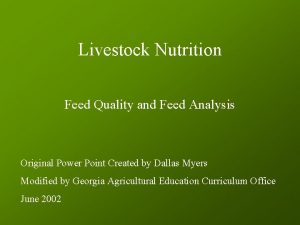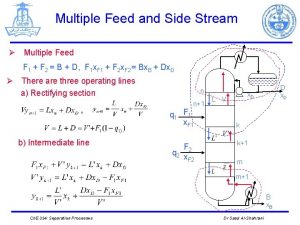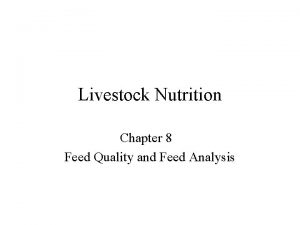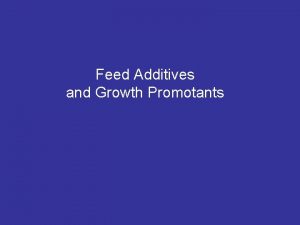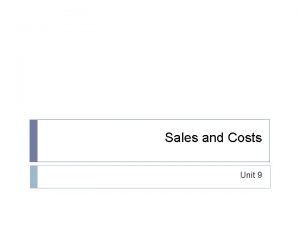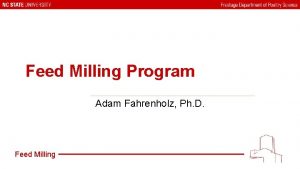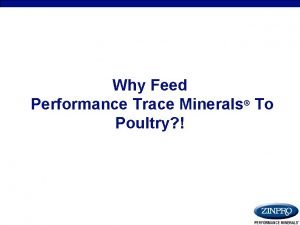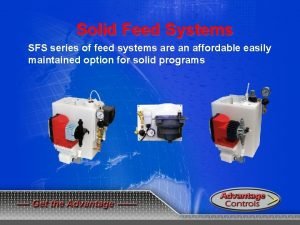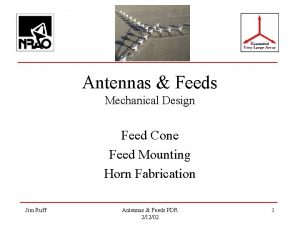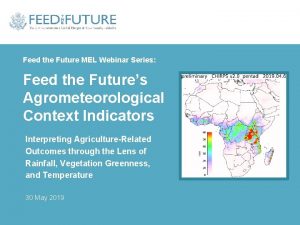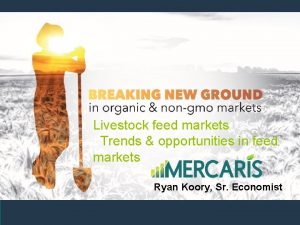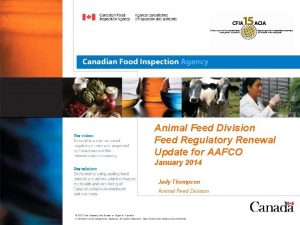New indicators Sales finance and investment Indicators Feed

































- Slides: 33

New indicators: Sales, finance and investment Indicators {Feed the Future MEL Webinar Series} July 18, 2018 EG. 3. 1 -14 EG. 3. 2 -26 EG. 3. 2 -27

Feed the Future MEL Webinar Series • Intro to the MEL System (recording available) • Standard Indicator Overview (recording available) • New Indicators: Application of improved practices and technologies (recording available) • New Indicators: Sales, finance, and investment – Today! • New Indicators: Yield and geospatial • New Indicators: Gender • Nutrition Indicators • Learning Agenda • Market Systems Measurement • Annual FTFMS users webinar 2

Presenters Lesley Perlman Julie Mac. Cartee Patrick Starr Anne Swindale Zachary Baquet 3

Webinar objectives • Key points of definitions and disaggregations to enable better data collection and reporting for: – EG. 3. 1 -14 Value of new USG commitments and private sector investment leveraged by the USG to support food security and nutrition [IM-level] – EG. 3. 2 -26 Value of annual sales of farms and firms receiving USG assistance [IM-level] – EG. 3. 2 -27 Value of agriculture-related financing accessed as a result of USG assistance [IM-level] 4

Indicator definitions and changes 5

Indicator/PIRS-specific changes • Indicators in general have a greater focus on capturing changes throughout the value chain, including private sector partners, market participants, etc. • People-level indicators disaggregated by sex and age • Reporting notes for the more complicated indicators include examples for data entry 6

INDICATOR EG. 3. 1 -14 Value of new USG commitments and private sector investment leveraged by the USG to support food security and nutrition [IM-level] 7

EG. 3. 1 -14 Value of new USG commitments and private sector investment leveraged by the USG to support food security and nutrition [IM-level] • Includes both operating capital (e. g. , inputs or inventory) and long-term investments (e. g. , property, plant, and equipment and other fixed assets). • Includes both cash and in-kind co-investment from the private sector. • In-kind investments, which should be valued at market rates, could include legal or business development services. 8

EG. 3. 1 -14 Value of new USG commitments and private sector investment leveraged…cont • Key definitions: – “New USG commitments”: funds provided thru an award designed to leverage additional funds from private sector organizations • Report pre-project commitments at the outset of the award • Report in the reporting season for the year committed, if committed during implementation • Subsidies to structure a guarantee or insurance product do not count. – “Private sector”: formal companies, community-based organizations or nongovernmental organizations (NGO) managing for-profit nutrition, agriculture, and/or food system-related activities. 9

EG. 3. 1 -14 Value of new USG commitments and private sector investment leveraged…cont • Key definitions (cont): – “Investment” is defined as any use of private sector resources intended to increase future production, output, income, etc. Investments are reported on a yearly basis, in the reporting season for the year they are made. In-kind investments are recorded at market value in USD. – “Leveraged by the USG”: new investment was directly encouraged or facilitated by activities supported by the Feed the Future initiative. Usually, the Feed the Future activities will take the form of a grant, direct loan, guarantee, or insurance coverage from the USG. 10

EG. 3. 1 -14 Value of new USG commitments and private sector investment leveraged…cont • Disaggregates – USG commitment amount (using "commitment" to include funding in the form of direct loans or a grant); – Private sector partner leveraged amount (using "leveraged" to include both cash and in-kind investment valued at market rates from the private sector partner) 11

EG. 3. 1 -14 Value of new USG commitments and private sector investment leveraged…cont • A note on reporting: – Reported in USD – Convert local currency to USD at the average market foreign exchange rate for the reporting year or convert periodically throughout the year if there is rapid devaluation or appreciation. 12

INDICATOR EG. 3. 2 -26 Value of annual sales of farms and firms receiving USG assistance [IM-level] 13

EG. 3. 2 -26 Value of annual sales of farms and firms receiving USG assistance [IM-level] • Not just smallholder producers. Nonsmallholder producers and assisted private sector firms • A participant is …reached directly, …reached as part of a deliberate service delivery strategy, …participating in the market we strengthen. ” 14

EG. 3. 2 -26 Value of annual sales of farms and firms…cont. • In market systems approaches, activity participants include private sector firms with direct contact with the USG-funded activity and the producers and other customers buying from or selling to the USG-assisted firms. For example: – the USG assisted the participant farmer or participant firm – the USG assisted the market actor with whom the participant farmer or participant firm were directly engaged (bought or sold a product or service) 15

EG. 3. 2 -26 Value of annual sales of farms and firms…cont. • Annual sales include all sales of farms and firms participating in USG-funded activities • For participant farms, sales covers the value and volume of production that is sold, regardless of where the sale takes place • For assisted firms, sales includes the value of good and services at the point of sale, not when the sale is contracted • Sales don’t have to take place in the ZOI 16

EG. 3. 2 -26 Value of annual sales of farms and firms…cont. The Type of Product or Service sold by the producer or firm is the first level disaggregate. • Products: • • • Output: agricultural commodities; Inputs: seeds/planting material; Inputs: other non durable inputs; Inputs; durable equipment; Processed products/value added; Post-harvest storage/processing equipment. • Services: • Business services; • Information services; • Production support services. 17

EG. 3. 2 -26 Value of annual sales of farms and firms…cont. Other disaggregates: (under Type of product or service) • Type of producer/firm: • • • Producer – smallholder; Producer – non-smallholder; Firm – microenterprise; Firm – small and medium enterprise; Firm - large enterprise or corporation • Sex of producer or proprietor: male, female, mixed • Age of producer or proprietor: 15 -29, 30+, mixed 18

Layered disaggregates EG. 3. 2 -26 Value of Annual Sales… Type of prod or svc: Agricultural commodities: rice Producer: Smallholder Sex: male: Value, Volume, # participants Sex: female: Value, Volume, # participants Age: 15 -29: Value, Volume, # participants Age: 30+: Value, Volume, # participants Producer: Type of prod or svc: Inputs: Seeds and planting materials Non smallholder Firm: Microenterprise Sex: male: Value, Volume, # participants Sex: female: Value, Volume, # participants Sex: male: Value, # participant firms Sex: female: Value, # participant firms Sex: mixed: Value, # participant firms Age: 15 -29: Value, Volume, # participants Age: 30+: Value, Volume, # participants Age: 15 -29: : Value, # participant firms Age: 30+: : Value, # participant firms Age: mixed: : Value, # participant firms Firm: Small & medium enterprise Sex: male: Value, # participant firms Sex: female: Value, # participant firms Sex: mixed: Value, # participant firms Age: 15 -29: : Value, # participant firms Age: 30+: : Value, # participant firms Age: mixed: : Value, # participant firms 19

EG. 3. 2 -26 Value of annual sales of farms and firms…cont. • Approach to collecting: – Participant farmers and firms: census of all participants, farm and firm records – Participant farmers: sample based survey approach for participant producers in geographic area – Some participant farmers: sales approach. If an assisted firm purchased from contract farms (e. g. contracted to grow certified seed), sales of the certified seed from producers to the firms can be counted and reported as producer sales AND certified seed from firms to other producers can be counted and reported as firm sales – Note: The value of the same commodity at different points along the value chain e. g. harvested and improved/processed by different participants, can be counted more than once. 20

Your turn! 21

A USG implementer is assisting a private laboratory (a mediumsized enterprise owned by a 50 year old male) to multiply and grow pest- and disease-resistant orange-fleshed sweet potato (OFSP) sprouts by providing capacity development and links to finance. In the previous reporting year, the lab sold OFSP sprouts for a total of $10, 000 to 8 agrodealers. With the support of the implementer, these agrodealers - all women-owned single proprietor microenterprises who are youth - trained and contracted 25 female smallholder farmers who are youth to cultivate these sprouts to generate sweet potato cuttings. The same agrodealers then purchased 10, 000 bundles (each bundle contains 100 cuttings) for $22, 500 from the 25 contract farmers in the current reporting year, and then sold the cuttings to sweet potato farmers in the current reporting year for $30, 000, using SMS and radio advertisements to increase awareness on appropriate growing practices in the target area. 22

INDICATOR EG. 3. 2 -27 Value of agriculture-related financing accessed as a result of USG assistance [IM-level] 23

EG. 3. 2 -27 Value of agriculture-related financing accessed as a result of USG assistance [IM-level] • Captures debt (cash and in kind loans) and nondebt (equity financing) • USG assistance may consist of technical assistance, insurance coverage, guarantee provision, or other capacity-building or market-strengthening activities • Counts the amount of cash, non-cash and non debt financing disbursed to the participant (not just financing committed) • Also counts the number of participants accessing finance. Count each participant only once under each type of financing category (debt and non debt) 24

EG. 3. 2 -27 Value of agriculture-related financing accessed …cont • Debt financing: cash loans – count loans made by financial institutions (not by informal groups) • Debt financing: non cash – in kind lending is the provision of services, inputs or other goods up front with payment usually in the form of product • Non-debt financing: examples include equity, convertible debt, or other equity-like investments, and leasing 25

EG. 3. 2 -27 Value of agriculture-related financing accessed …cont • Disaggregates include: – – – type of financing (debt/not debt) type of debt (cash/in kind) size of recipient sex of producer/proprietor: M, F, mixed age of producer/proprietor: 15 -29, 30+, mixed 26

Layered disaggregates EG. 3. 2 -27 Value of ag financing… Type of financing: Debt Type of debt: Cash Sex: male: $/# Sex: female: $/# Sex: mixed: $/# Age: 15 -29: $/# Age: 30+: $/# Age: mixed; $/# Type of financing: Debt Type of debt: In-kind Size of recipient: small and medium enterprises: $/# Sex: male: $/# Sex: female: $/# Sex: mixed: $/# Age: 15 -29: $/# Age: 30+: $/# Age: mixed; $/# Size of recipient: Individuals/microenterprises: $/# Size of recipient: small and medium enterprises: $/# Size of recipient: large enterprises and corp; $/# Size of recipient: Individuals/microenterprises: $/# Type of financing: Nondebt Sex: male: $/# Sex: female: $/# Sex: mixed: $/# Age: 15 -29: $/# Age: 30+: $/# Age: mixed; $/# Size of recipient: Individuals/microenterprises: $/# Size of recipient: small and medium enterprises: $/# Size of recipient: large enterprises and corp; $/#

Your turn! 28

The same USG implementer from the previous problem also supported the 8 agrodealers to access financing from the local bank in the first reporting year of the project. These agrodealers - all women-owned single proprietor microenterprises - received business management and basic accounting training, as well as assistance in putting together business plans. The agrodealers then used their new skills and business documents to each apply for a $10, 000 loan from the bank. All 8 were successful, but only 4 of the firms received the financing before the end of the reporting year. The other 4 received financing in the next reporting year. 29

Transitioning to the new sales, finance, and investment indicators 30

Indicator Transition Activity-level indicators: - Activities end before Oct 2019: New indicators optional - Activities end after Sep 2019: New indicators mandatory Reporting in FTFMS: - Fall 2018: set targets new indicators for FY 19 -21, report on results for new indicators if fully aligned with definition, otherwise report on old indicators - Fall 2019: report against new indicators for FY 2019 31

Questions? 32

Feed the Future MEL Webinar Series • Intro to the MEL System (recording available) • Standard Indicator Overview (recording available) • New Indicators: Application of improved practices and technologies (recording available) • New Indicators: Sales, finance, and investment – Today! • New Indicators: Yield and geospatial • New Indicators: Gender • Nutrition Indicators • Learning Agenda • Market Systems Measurement • Annual FTFMS users webinar 33
 Feed up, feedback
Feed up, feedback Feed up feed back feed forward
Feed up feed back feed forward Perbedaan feed additive dan feed supplement
Perbedaan feed additive dan feed supplement Sistem down feed
Sistem down feed Feed additive dan feed supplement
Feed additive dan feed supplement Fixed investment and inventory investment
Fixed investment and inventory investment Sadc protocol on finance and investment
Sadc protocol on finance and investment Financing and investing cycle
Financing and investing cycle Investing cycle in auditing
Investing cycle in auditing Investment banking activities
Investment banking activities Sales force structure adalah
Sales force structure adalah Difference between sales letter and sales promotion letter
Difference between sales letter and sales promotion letter Sales deployment
Sales deployment Clover leaf routing plan
Clover leaf routing plan Sales potential vs sales forecast
Sales potential vs sales forecast Mobile home parks for sale in sc
Mobile home parks for sale in sc Oak springs mobile home park
Oak springs mobile home park Wrasse and bass relationship
Wrasse and bass relationship Ritchie feed and seed
Ritchie feed and seed Milling machine introduction
Milling machine introduction Ritchie feed and seed
Ritchie feed and seed New york, new jersey, pennsylvania, and delaware
New york, new jersey, pennsylvania, and delaware Fresh oil, new wine scripture
Fresh oil, new wine scripture Characteristics of the articles of confederation
Characteristics of the articles of confederation New consumer capabilities in marketing
New consumer capabilities in marketing New classical macroeconomics
New classical macroeconomics Chapter 16 toward a new heaven and a new earth
Chapter 16 toward a new heaven and a new earth Neil thisse is a loyalist who fled the colonies
Neil thisse is a loyalist who fled the colonies New classical and new keynesian macroeconomics
New classical and new keynesian macroeconomics Undelies
Undelies Interlanguage and social identity and investment
Interlanguage and social identity and investment Language spanish
Language spanish 2row vs 6row feed barley
2row vs 6row feed barley Yahoo weather radar
Yahoo weather radar
